Tour de France Bicycles, Historical Bike Weights & Technology
Author’s note: I first wrote this article in 2010, but I have updated it every year since.
After swapping my 1992 Cannondale 3.0‘s hodgepodge of Campagnolo components for Shimano Dura-Ace 7700, the bike weighs in at 19.0 pounds with pedals. In this day and age of ultra-light (and über-expensive) vélos bedecked with enough carbon fiber to embarrass a B2 Stealth Bomber, this seems a bit portly and admittedly, she could easily lose another 1.5 lbs. if I cared to spend a few hundred dollars for a lighter wheelset, saddle and handlebar.
But can you believe that my C’dale actually weighs less than the bicycles that Miguel Indurain, Jan Ullrich and Bjarne Riis rode to Tour de France victory in the mid- to late 90s? And every winning Tour bike before that!
Below are some of the bikes ridden to glory in the modern Tour de France era. Bike weights hovered between 18 and 22 pounds from 1968 to 1998, after which they plummeted especially with Lance Armstrong demanding every technological advantage. In the new millenium, Union Cycliste Internationale (UCI) imposed a minimum weight requirement of 15.0 pounds (6.8 kilograms) for bicycles raced in international events under their jurisdiction—including the Tour de France—so the lightest bike ever ridden to overall Tour victory may have been Armstrong’s 2003 Trek 5900 SL, rumored to be 14.5 pounds. (That win was later nullified.)
Some other observations are below. [August 11, 2013: Items below that are struck out are due to disqualifications of once-declared victors like Lance Armstrong implicated in doping scandals.]
- In the last 40 years, a handful of bicycle manufacturers have dominated the race for the yellow jersey: Pinarello (15 as of August 2020), Gitane (with 9 or 12 victories), Peugeot (10), and Trek (10). Read this post for a detailed analysis and controversies regarding which bike company has won the most.
- TVT (of France) claims to have at least 5 victories spanning from 1986-1991. Their bikes were frequently rebadged as other marques.
- 1973 was the first time the Tour was won on a titanium bike. Luis Ocana was riding a Speedwell Titalite frameset, although it may have been badged as a Motobecane. (Thanks to Robert Child for this info.)
- Bernard Hinault was the first cyclist to the Tour win using clipless pedals, in 1985. Stephen Roche was the last to win using toe clips and straps, in 1986.
- In 1999, Lance Armstrong’s time-trial bike was a Trek-badged titanium Litespeed Blade, which was another time a Tour de France victory (later nullified) was achieved using a titanium bicycle.
- 1994 was the last time the Tour was won a steel bike—a TIG-welded Pinarello-badged beauty ridden by Miguel Indurain.
- Indurain and Bjarne Riis rode TIG-welded metal-matrix frames to victory in 1995 and 1996, respectively.
- Aluminum bicycles were ridden to glory by Jan Ullrich and Marco Pantani in 1997 and 1998, respectively.
- Ever since Lance Armstrong lead the Tour on a stock Trek OCLV in 1999, every winning bike has been made completely out of carbon fiber except for Oscar Pereiro’s Pinarello Dogma, which had main tubes made out of an AK61 magnesium alloy and rear triangle made out of carbon fiber.
- In 2000, the UCI instituted a minimum bicycle weight limit of 6.8 kilograms (15.0 pounds). However, James Huang of CyclingNews.com claimed (perhaps mistakenly?) that it only went into effect at the Tour de France in 2004.
- Nowadays (2020s) it is commonplace for TdF bicycle manufacturers to optimize frame aerodynamics even for non-TT stages. But Trek was doing this even in 2004 with its Madone 5.9, which reportedly saved 10 watts during wind-tunnel testing.
- Shimano finally had a win in the Tour starting in 1999 2007.
- For the climbing stages in all seven of Lance Armstrong’s TdF overall first-place finishes, he used a downtube front shift lever to save weight (about 2-3 ounces). Nowadays, combination brake/shift levers (such as SRAM Red) are just as light as a separate downtube and brake lever—and bicycle manufacturers don’t even put braze-ons for downtube levers on their frames anymore. Therefore, 2005 was the last year that downtube levers were used by someone who stepped on the top rung of the podium for the TdF general classification.
- Alberto Contador’s Trek Madone 5.2 in 2007 was the first* Tour-winning bike with a mountain bike-like sloping top tube. Now almost all modern race bikes have “compact” frames, with the main holdouts being Cannondale and Pinarello.
*It has been claimed that Marco Pantani’s 1998 bikes had slightly sloping top tubes. - SRAM had its first victory in 2009 with Alberto Contador. It won again in 2010 despite Andy Schleck’s infamous chain-drop incident. (He was awarded the TdF victory after Alberto Contador tested positive for clenbuterol.)
- Cadel Evan was the first TdF winner using electronic shifting (Shimano Di2 on a BMC Teammachine SLR01) in 2011.
- In the 2010s, two Tour de France winners used ovalized chainrings. Both Bradley Wiggins (2012) and his teammate Chris Froome (the victor in 2013, 2015, 2016, and 2017) employed parts by Osymetric. But while Chris Froome continues to use them in the 2020s, every participant of the 2023 Tour de France used round chainrings.
- By 2013, all teams were using 11-speed cassettes. Electronic shifting and disc brakes were adopted around this time too.
- In late 2016, the UCI scrapped its 3:1 rule governing tube shapes. This opened the door for more aerodynamic designs somewhat (it still specifies minimum and maximum tube dimensions).
- Around 2018, more and more bicycle manufacturers were designing their bicycles with “dropped” seatstays. Supposedly they are more aerodynamic and allow more compliance than traditional seatstays that meet at the junction of the top tube and seat tube.
- 2020 was when a 12-speed cassette (Campagnolo) was first successfully used for overall TdF victory. (Campagnolo debuted 12-speed in 2018, SRAM in 2019, and Shimano in 2021.)
- From the early 2000s to roughly 2020, most bicycles used were around the 6.8-kilogram (15.0-pound) UCI weight limit. But then bicycles got heavier due to an increased focus on aerodynamics. Also, most teams were using disc brakes, wider tires, electronic shifting, and power meters. The lightest bicycles were usually the ones reserved for super hilly climbing stages.
- Tadej Pogačar (2021) was the final overall Tour de France winner to use rim brakes. (The first time someone won a TdF stage using disc brakes was probably Stage 2 of the 2017 edition.)
- By 2023, most teams had ditched tubulars for tubeless tires. (This was nine years after I had done so myself.)
- In 2023, Jonas Vingegaard was the first TdF winner to use 1X shifting in select stages.
- Tadej Pogačar was likely the first overall winner to use 165mm cranks (2024).
- 2024 was the first year that no cyclist used Campagnolo components in the Tour de France.
- 2025 was the first year that every stage was won on tubeless tires.
| Year | Winning Racer | Bicycle Manufacturer | Weight, lbs. (kg) | Notes |
|---|---|---|---|---|
| 1962 | Jacques Anquetil | Helyett | 22.4 (10.2) | [1] |
| 1965 | Felice Gimondi | Magni | 24.2 (11) | [1] |
| 1967 | Roger Pingeon | Peugeot | 22.9 (10.4) | [1] |
| 1968 | Jan Janssen | Lejeune | 19.1 (8.7) | [1] |
| 1972 | Eddy Merckx | Eddy Merckx (Colnago) | 21.1 (9.6) | [1] |
| 1973 | Luis Ocaña | Motobecane | 18.7 (8.5) | [1]; a titanium Speedwell Titalite frameset |
| 1976 | Lucien Van Impe | Gitane | 18.3 (8.3) | [1] |
| 1977 | Bernard Thévenet | Peugeot | 22.0 (10.0) | [1] |
| 1980 | Joop Zoetemelk | Raleigh | 22.4 (10.2) | [1] |
| 1985 | Bernard Hinault | Hinault | 21.1 (9.6) for time-trial bike | [1] |
| 1987 | Stephen Roche | Battaglin | 21.1 (9.6) | [1] |
| 1988 | Pedro Delgado | Pinarello (built by TVT) | 21.6 (9.8) | [1],[6]; carbon-fiber TVT frame |
| 1989 | Greg LeMond | Bottechia (built by TVT) | ? | [6]; carbon-fiber TVT frame |
| 1990 | Greg LeMond | LeMond | 20.0 (9.1) for time-trial bike | [1] |
| 1993 | Miguel Indurain | Pinarello | 22.7 (10.3) | [1] |
| 1994 | Miguel Indurain | Pinarello | 22.5 (10.2) | Frame TIG-welded by Dario Pegoretti from Dedacciai/Oria tubing; 59-cm frame; Campagnolo 8-speed C Record Group |
| 1995 | Miguel Indurain | Pinarello Espada | 17.8 (8.1) for time-trial bike | [1]; last to win the TdF on a steel-framed bicycle |
| 1996 | Bjarne Riis | Pinarello | 19.8 (9.0) | [1] |
| 1997 | Jan Ullrich | Pinarello | 19.8 (9.0) | [1] |
| 1998 | Marco Pantani | Bianchi; Bianchi Mega Pro XL Reparto Corse (mountain stages) | 17.8 (8.1); 15.34 (6.96) climbing bike | [1] |
| 1999 | Lance Armstrong | ? | [2]; frameset: 3.9 lbs. (1.750 kg). 1″ head tube, threaded chromoly steerer, 9-speed Dura-Ace; Litespeed Blade was titanium | |
| 2000 | Lance Armstrong | ? | [2], [5]; 5500 frameset: 2.8+.9=3.7 lbs. (1.25+.42=1.67 kg), 1-1/8″ head tube, threadless aluminum steerer, 9-speed Dura-Ace; 5900 frame: 2.2 lbs. (1.0 kg) for mountain stages | |
| 2001 | Lance Armstrong | Trek 5900 | ? | [2]; 9-speed Dura-Ace, still used downtube front shifter for mountains |
| 2002 | Lance Armstrong | Trek 5900 | 18.0 (8.2) | [1] |
| 2003 | Lance Armstrong | Madone: 15.8 (7.2); 5900: 14.5 (6.6) | [1],[2],[5]; 5900 Ultralight frame: 2.2 lbs. (.98 kg) | |
| 2004 | Lance Armstrong | Trek Madone SL, Madone SSL (mountain stages) | [3] | [2],[4],[5]; frameset: 2.4+.7=3.2 lbs. (1.100+.340=1.440 kg) |
| 2005 | Lance Armstrong | Trek Madone SSLx, TTX (time trial) | [3] | |
| 2006 | Oscar Pereiro | Pinarello Dogma-FPX | [3] | Magnesium AK61 Superlight |
| 2007 | Alberto Contador | Trek Madone 5.2 | [3] | Shimano Dura Ace; first official win by a Shimano-equipped bicycle. |
| 2008 | Carlos Sastre | Cervélo R3-SL | [3] | Shimano Dura Ace; Rotor Q-Ring elliptical chainrings mounted on FSA crankarms |
| 2009 | Alberto Contador | Trek Madone 6-Series | 15.0 (6.8) | SRAM Red; first win by a SRAM-equipped bike |
| 2010 | Alberto Contador Andy Schleck | Specialized Tarmac SL3, Roubaix SL3 (cobblestones) | [3] | SRAM Red |
| 2011 | Cadel Evans | BMC Teammachine SLR01 | [3] | first TdF winner using electronic shifting (Shimano Dura-Ace Di2); Speedplay pedals with short spindles |
| 2012 | Bradley Wiggins | Pinarello Dogma 65.1 Think 2 | [3] | Shimano Dura-Ace Di2 10-speed; Speedplay pedals; Osymetric oval chainrings |
| 2013 | Chris Froome | Pinarello Dogma 65.1 Think 2 | [3] | 126mm stem, 40cm bars; 172.5mm Dura-Ace cranks; Osymetric oval chainrings; 23mm Veloflex tubulars |
| 2014 | Vincenzo Nibali | Specialized Tarmac, Roubaix (cobblestones), Shiv (time trial) | [3] | Tarmac: Campagnolo Super Record mechanical groupset; FSA carbon fiber handlebars, stem and seatpost; Veloflex Carbon 700X23c tubulars |
| 2015 | Chris Froome | Pinarello Dogma F8 | [3] | Shimano Dura-Ace Di2; Osymetric oval chainrings |
| 2016 | Chris Froome | Pinarello Dogma F8 XLight | [3] | Shimano Dura-Ace Di2 9070; Osymetric oval chainrings; Stages power meter |
| 2017 | Chris Froome | Pinarello Dogma F10 | [3] | Shimano Dura-Ace Di2 9100 with custom bar-tops switch; Osymetric oval chainrings |
| 2018 | Geraint Thomas | Pinarello Dogma F10 XLight | [3] | Shimano Dura-Ace Di2 R9170 |
| 2019 | Egan Bernal | Pinarello Dogma F12 | [3] | Shimano Dura-Ace R9100; used Shimano wheels for most stages but Lightweight Meilenstein Obermayer wheels for climbing stages (saved ~400g) |
| 2020 | Tadej Pogačar | Colnago V3Rs | [3] | rim-brake model; Campagnolo 12-speed; Colnago’s first TdF victory |
| 2021 | Tadej Pogačar | Colnago V3Rs | [3] | disc-brake model for 17 of 21 stages; Campagnolo Super Record EPS |
| 2022 | Jonas Vingegaard | Cervélo S5, R5 (mountain stages), P5 (time trial) | [3] | Shimano Dura-Ace Di2 R9200 12-speed; second TdF victory for Cervélo and first since 2008 |
| 2023 | Jonas Vingegaard | Cervélo S5, R5 (mountain stages), P5 (time trial) | 15.9 (7.195) for S5, 15.2 (6.9) estimated for R5 | Vingegaard’s Jumbo-Visma team switched from Shimano to SRAM Red eTap AXS this year; used 1X for first and last stages |
| 2024 | Tadej Pogačar | Colnago V4Rs | 15.9 (7.2) | 165mm cranks; Enve SES 6.7 wheels (60mm front/67mm rear depth) and custom SES one-piece handlebar; Shimano Dura-Ace 2X12 but with some Carbon Ti parts |
| 2025 | Tadej Pogačar | Colnago TT1 for Stage 5 flat TT; Colnago Y1Rs for all other stages, including mountain TT | 16.5 (7.5) most stages; 15.2 (6.9) Stage 13 | For the Stage 13 mountain time trial, Pogačar used a modified Y1Rs with no paint or bar tape, 25mm-wide TT tires, lighter saddle and wheels. |
References:
- Les Velos Mythiques Vainquers du Tour de France by Yves Blanc and Bruno Bade, as described in the Starbike Weight Weenies Forum.
- Lance Armstrong’s Tour de France-winning machines, James Huang, CyclingNews.com, July 2007.
- The UCI minimum weight limit of 15.0 lbs. (6.8 kg) was instituted in 2000. (Journalist James Huang, perhaps mistakenly, wrote that it came into effect at the Tour de France in 2004.) It still applies today and includes the weight of non-easily-removed accessories (e.g., pedals, water bottle cages, power meters) that bicycle manufacturers usually do not take into account when they advertise. (Water bottles and cycle computers don’t count.) It can be presumed that Tour de France teams aspire to use bicycles that weigh little more than the UCI limit, particularly for climbing stages. This was easily attainable until roughly 2020, when teams started to priortize aerodynamics, disc brakes, wider tires, tubeless tires, 12-speed cassettes, and electronic shifting, for example.
- Other components Armstrong used are described in Wired Magazine, July 2004.
- Lance Armstrong’s Tour de France Bikes, Chain Reaction Bicycles, 2001.
- From TVT’s letter. Thanks to James Greenlees for sending me it.
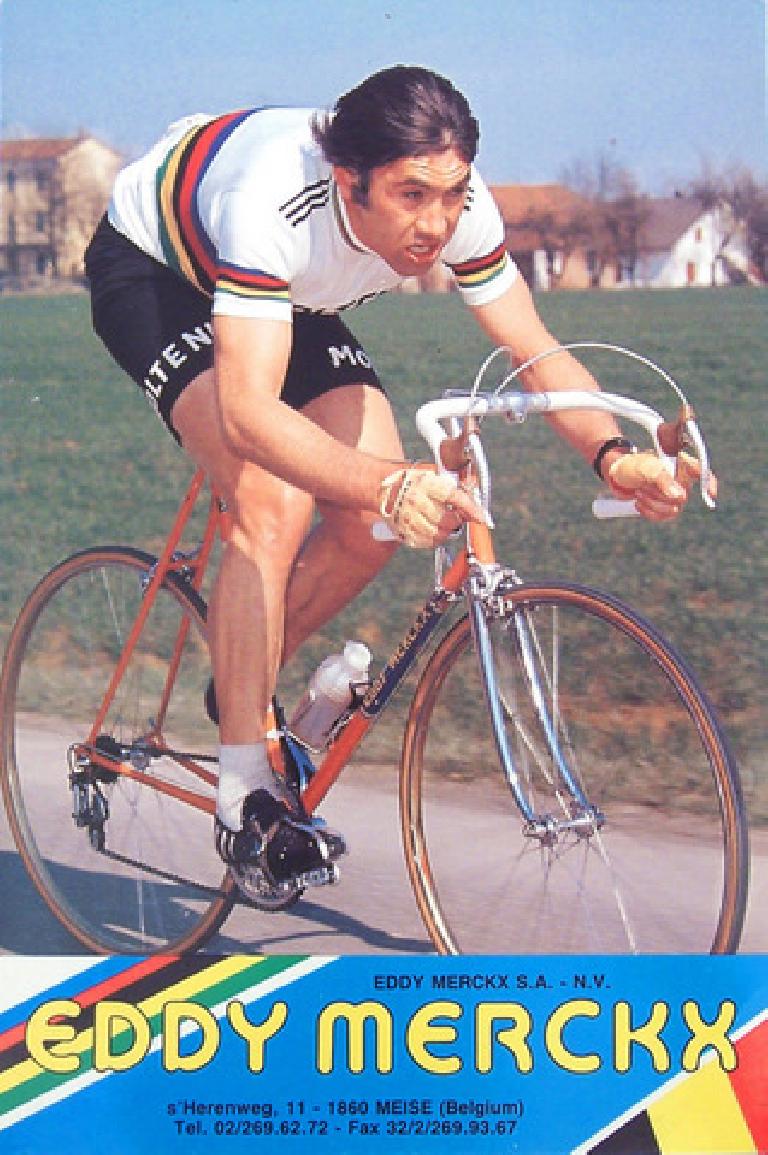

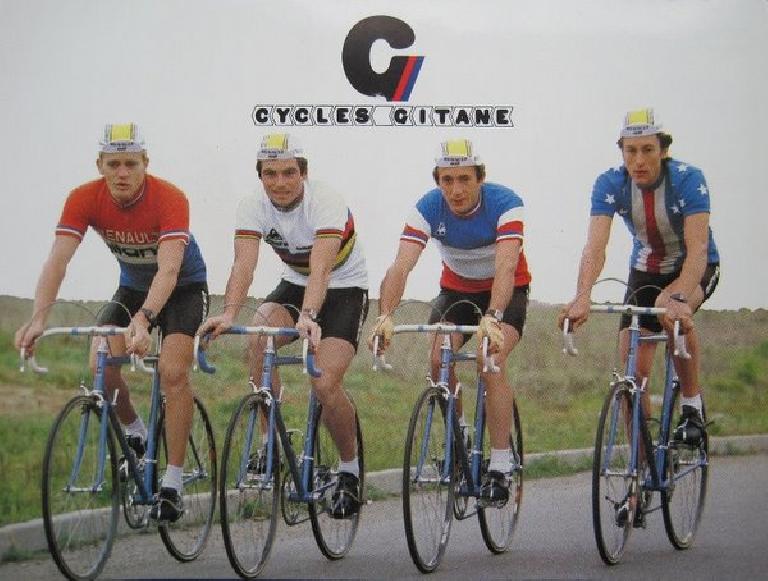
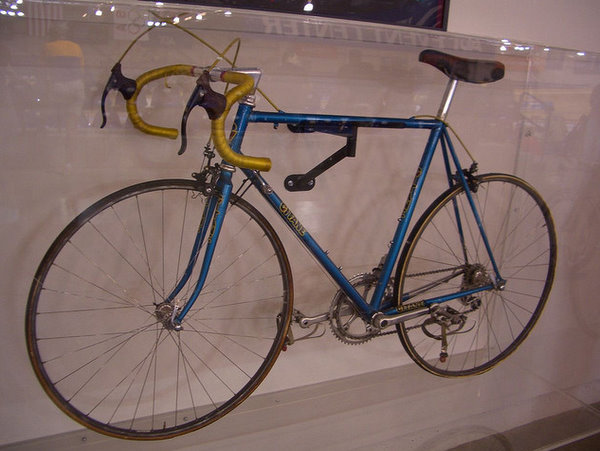
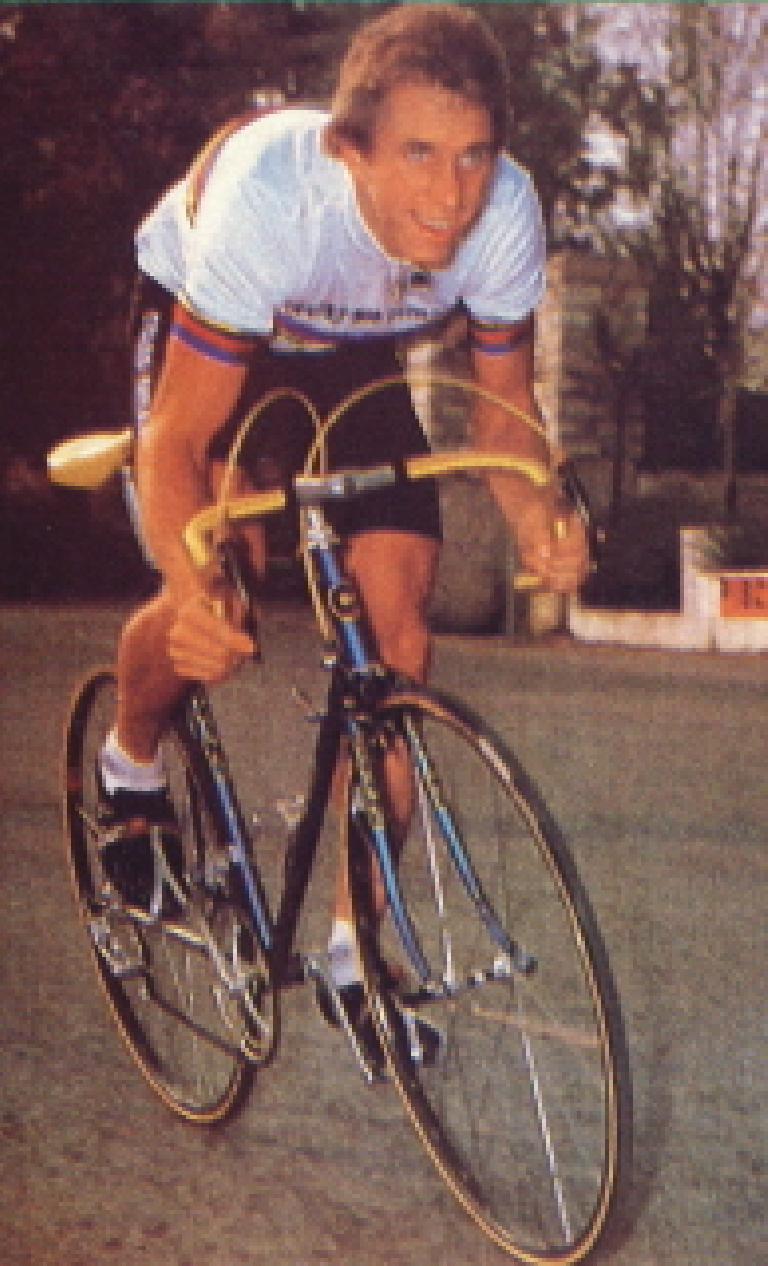
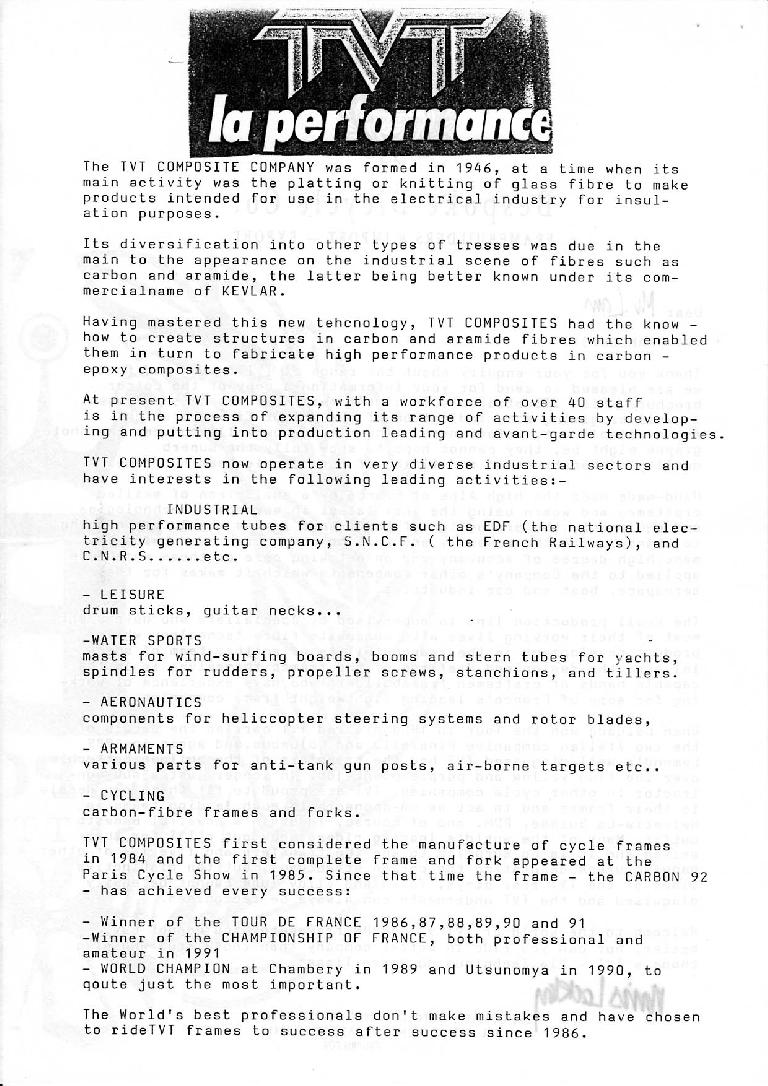
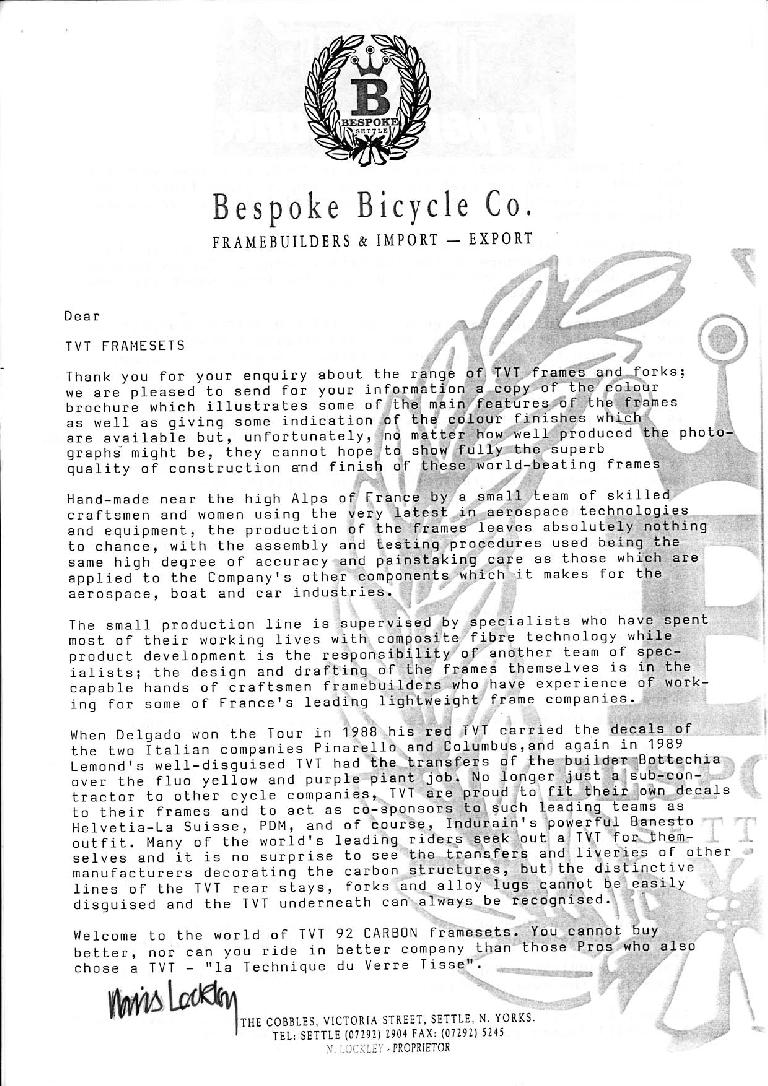



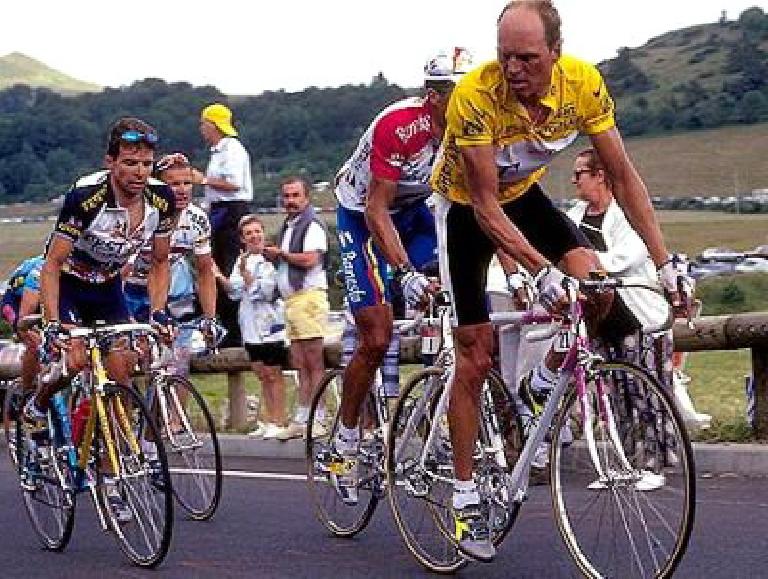
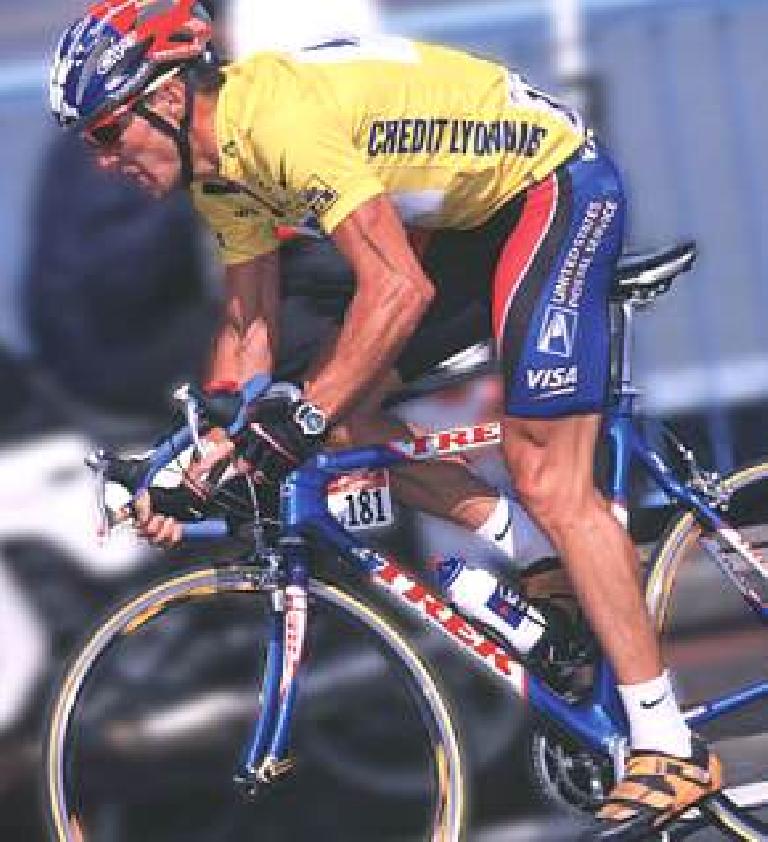
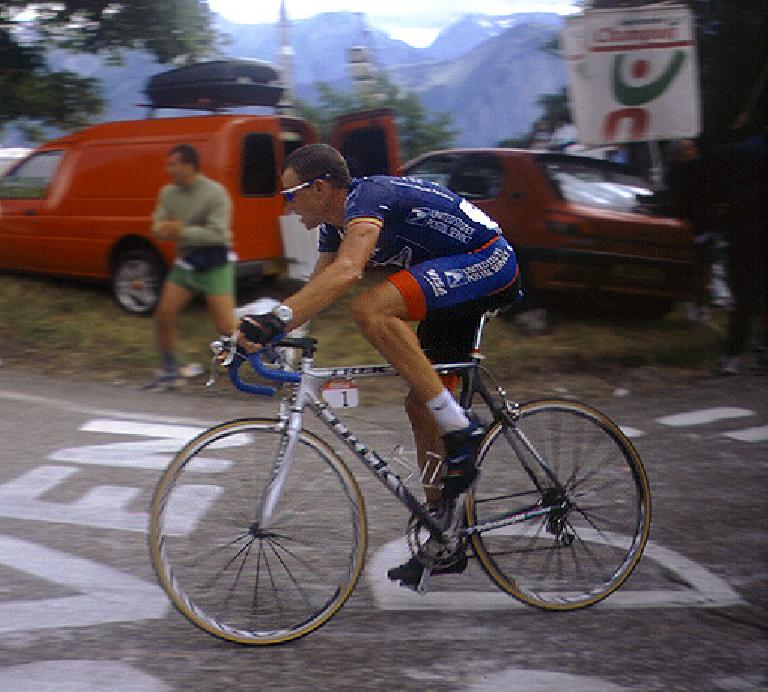
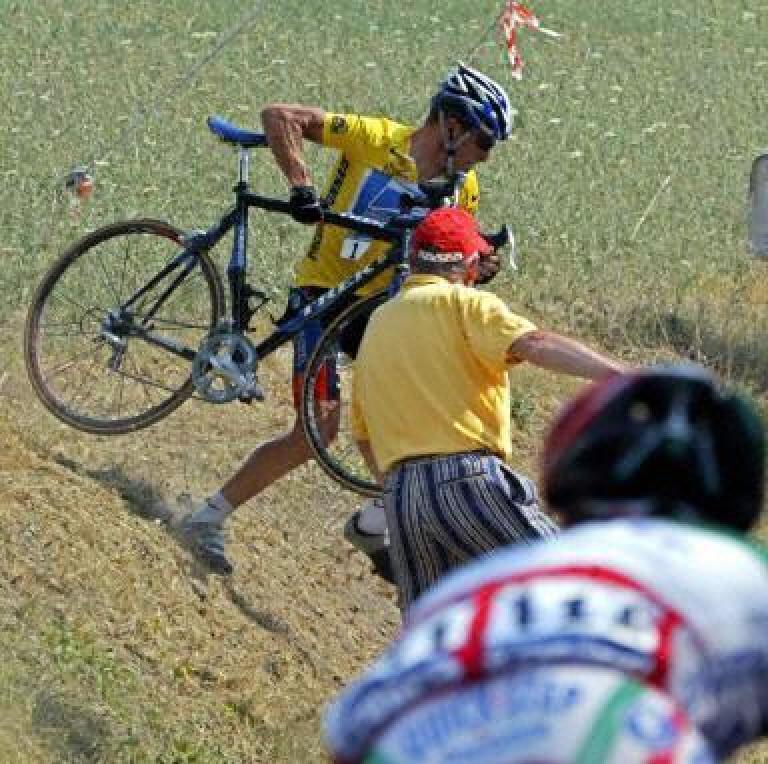
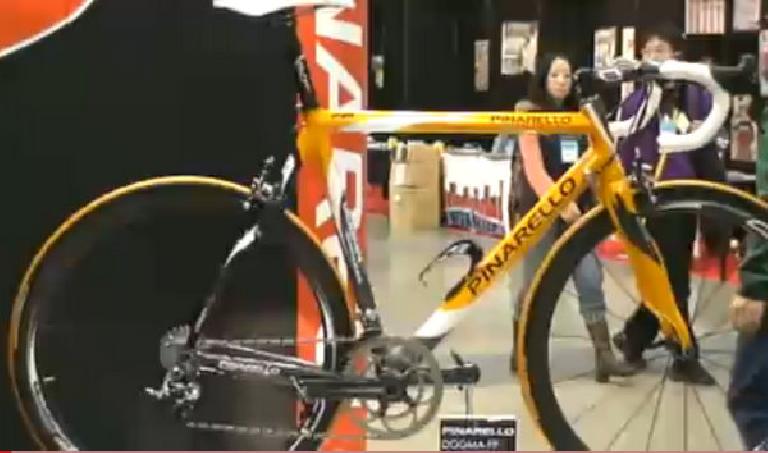
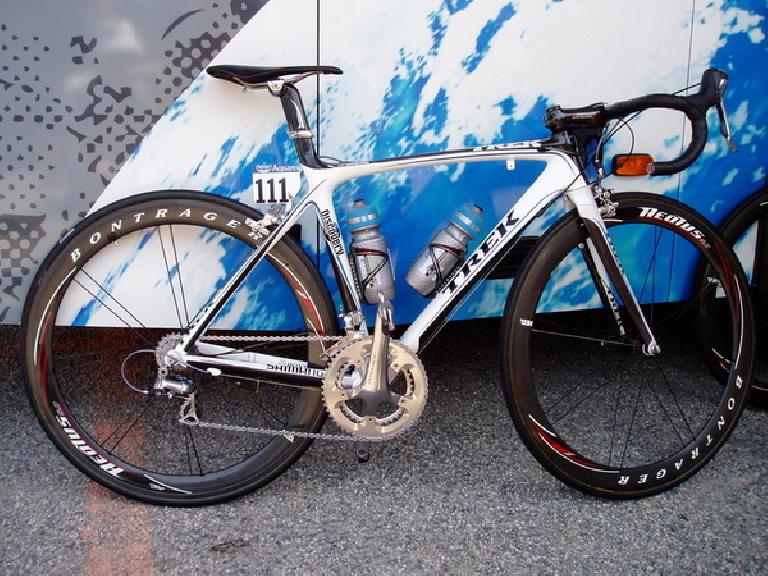

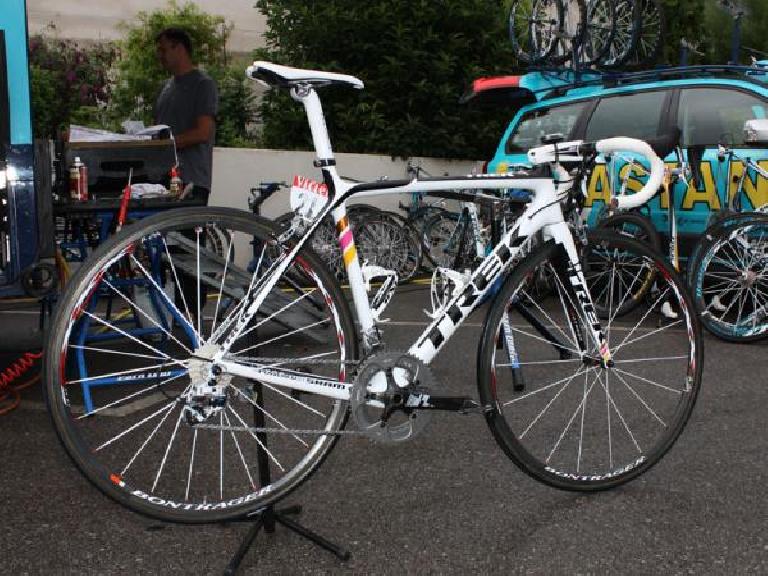
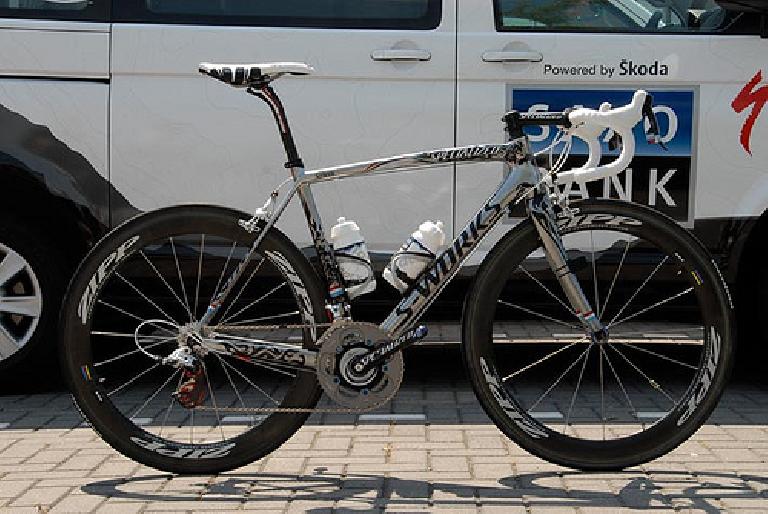
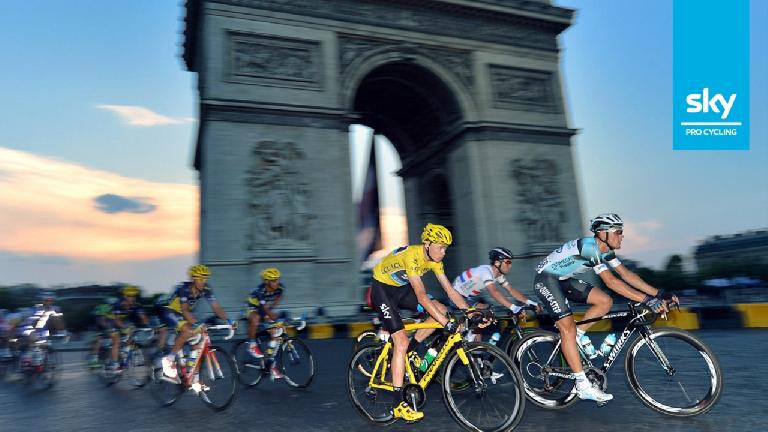
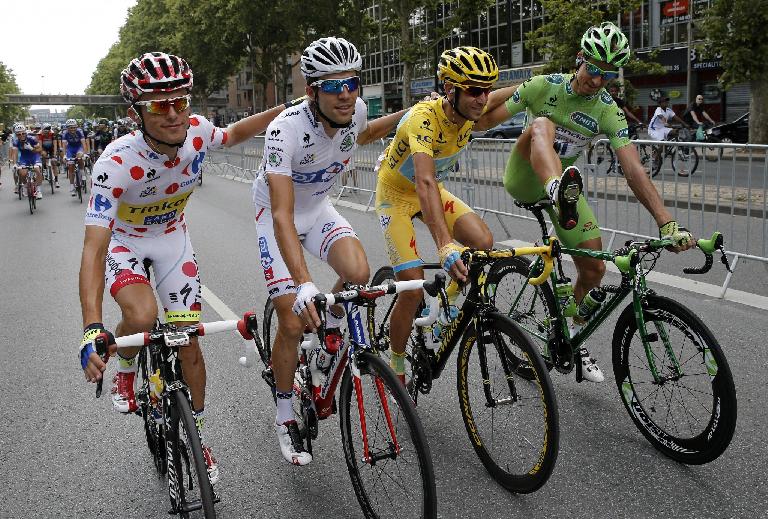
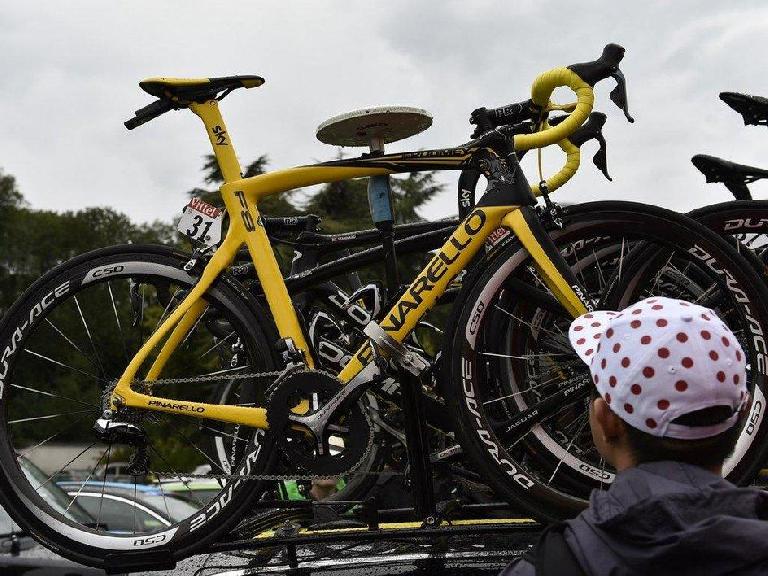
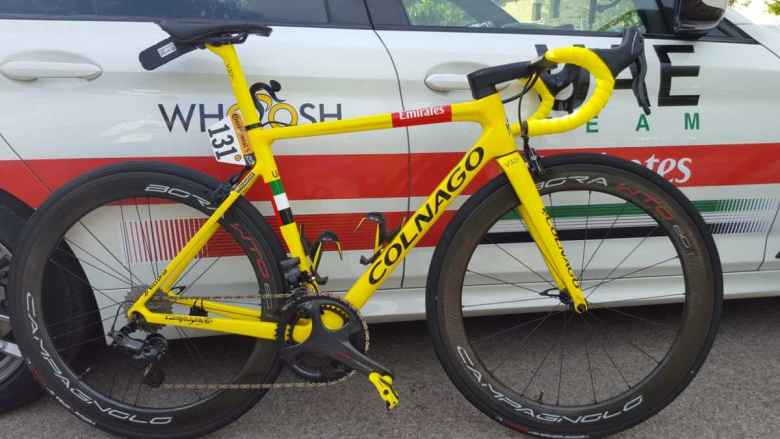
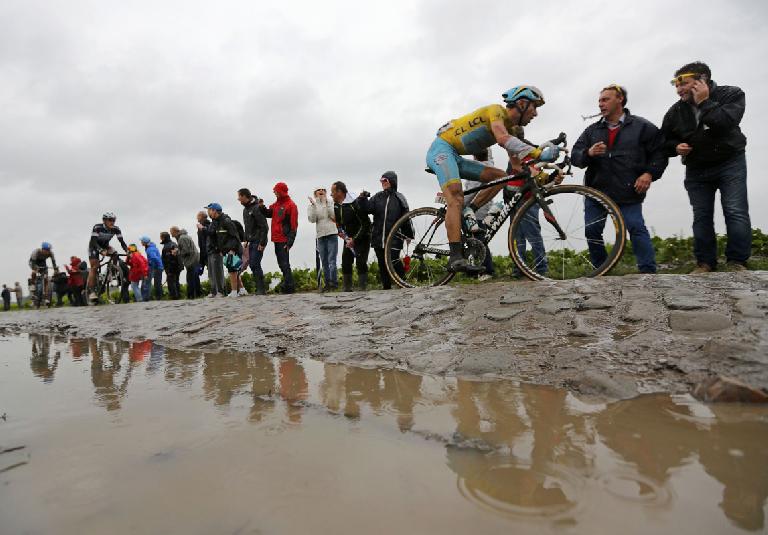

There are 16 comments.
never ceased to amaze me that armstrong demanded such attention to detail on the bike weight and then rode with a gold chain round his neck.
Why cross out Armstrongs bikes? They didn't dope, he did. SMH
I guess that could be added as another part to the list of controversies :)
https://felixwong.com/2017/07/which-bicycle-manufacturers-have-won-the-tour-de-france-the-most/
How things have come on since the early 00's.
Our first thoughts are probably related to frames but wheels, groupos and other detail parts must have come on strides; plenty of steel framed bikes out there now that are close to or even below the UCI limit...
Love this info. I am working on a novel in which the 1974 Tour figures prominently. I notice that the year's 74 and 75 are missing from your chart. Why? And can you tell me what Merckx rode to the winner's podium in those years and also suggest what were the major bikes riders were on during those years? The details are important to me in the telling of my story. I would greatly appreciate it. Thank you and keep up the great work. That's a beautiful Gitane up there.
Hi nice web site.
What about TVT bikes?
eg: Lemond in 1990 used one.
Thanks.
Luis Ocaña rode some stages on a Speedwell Titanium frame. I had one probably weighed about 18 LBS. Andy Gilmour
"Ever since Lance Armstrong lead the Tour on a stock Trek OCLV in 1999, every winning bike has been made out of carbon fiber."
Oscar Pereiro 2006?
Thanks for stopping by my website and for pointing out Oscar Pereiro's bike!
It appears his winning bike was made out of magnesium for the main tubes, and carbon fiber for the rear triangle and fork:
That certainly warrants a mention on the page. I've updated now.
Hi,
Thanks for putting this together - its an interesting read. However I999 wasn't the first time a titanium bike was ridden in the TDF, in fact Ocana won the 1973 tour on a titanium Speedwell frame, which was badged as a Motobecane. Ocana's winning bike wasn't made in France, but the manufacturing heartland of Great Britain - Birmingham !!!
Best wishes
Rob
Thank you for the information, Rob! I have confirmed it and updated the page now. Happy cycling.
The cost of a tour de France bike is highly dependent on the style, technology, and construction of the equipment. For professional bike pricing, UCI allows disc brakes to be used during the Tour de France. Now, a competition bike has at least one disc brake frame and one associated grouping unit.
I'm glad I "lived" through what are now part of the halcyon/platinum years of the 1960's, 1970's, 1980's...... Before the sport was bastardized and lost its soul. For that matter its heart.
Today and for well into essentially 20 years it's clearly, increasingly become so plastic. So false as it were. Weight weenies/techno/"aero" twinks are now today's "cyclists" on their poofda plastic, Made In China rigs, spinning endlessly, crashing endlessly. It IS so sad.
John, I have a late 1920's Alcyon (French) racing bicycle, similar to the the bikes ridden to TdF victories by Nicolas Frantz in 1927 and 1928. It weighs just under 26 pounds with all steel components (aluminum components were not available until the 1930's), except the wooden tubular rims. and leather saddle and toe straps. It has no derailleurs (they were banned from the TdF until 1937) but it has a 2 speed freewheel on one side of the rear hub and a fixed cog on the other. Gears were changed by removing the rear wheel with large brass wing nuts and moving the chain to another cog based on the grade, The fixed gear was larger, and used for climbing!
I started racing bicycles in 1974 when "steel was real" and there were no electronic devices, but there were hints of new technologies like the Teledyne Titan and Exxon Graftek bicycles in the mid 1970's, and the Polar heart rate monitor in 1978.
My point is that technology always marches on, unless rules are written to discourage it, like derailleurs before 1937, etc.
First clipless pedal TDF win 1986, last toe clip win was 1987
That's a good one! Thanks for the input. I've added this along with a link that corroborates this fact.